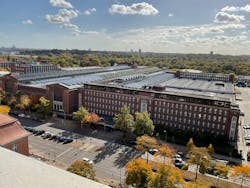Siemens is Building its Future on Data—and its Own Land
RELATED
Pointing to the Future, Siemens Celebrates its Legacy
On a clear day on a rooftop in Berlin, you can see the future.
The 180-acre site where Siemens built its base of operations at the turn of the 20th Century now will be reimagined as a multi-functional urban district for the 21st Century and beyond. The sprawling mixed-use area called Siemensstadt Square will bring residential, commercial, retail and industrial users together in a world of interconnected and interdependent technologies.
Environmental sustainability permeates every facet of the project. Transportation systems actually will be a throwback to the original days of Siemens in this area: A light rail electric system will be revived to connect Siemensstadt Square to other parts of the city. It will capture and reuse rainwater and be barrier-free in every service from waste disposal and mobility solutions.
The 10-year project is in the conceptual stages, and is being fully designed using the digital twin, the cornerstone of Siemens’ transformation from a hardware vendor to a software provider. The PLC—once the cornerstone of the Siemens business, and which it claims still is deployed on about one-third of all machines in the world—will be little more than a data hub. System control will be a multidisciplinary and fully digital enterprise that will take machines from design to end of life recycling.
At the Siemens Digital Media Day in Berlin on Oct. 13, company officials touted this new digital age and the need to change not just how machines are made, but how they are optimized and how they utilize another scarce commodity—the human talent available to manufacturing.
“You need data flow from design to manufacturing to maintenance. You need data flow from the sensor, bring it into context, and then do further optimization,” said Reiner Brehm, CEO of Factory Automation for Siemens Digital Industries. “You need to connect the horizontal design-to-manufacturing function to the vertical shop floor-to-top floor. You need to connect the knowledge of the OT world with the knowledge of the IT world. And this needs constant optimization.”
The use of simulation software continues to increase, but the idea of running a digital twin of an operating plant in parallel with actual production still is in its infancy. Yet Siemens officials are clear that they see this as the future of their company and, by extension, of operations of all kinds.
“We want to make it easy for our customers to go into the future,” said Peter Korte, CTO of Siemens AG, in opening remarks to the 80 media representatives from 18 countries. He said the recent introduction of the company’s flagship Xcelerator digital platform is the foundation of the company’s transformative plans.
Korte noted that its survey of customers found that 86% have concerns about digitization due to the legacy systems within the plant. Another 45% stated they still struggle to implement IoT technology, and 40% find it difficult to find digital partners that can help them realize the digital future.
Siemens hopes the Siemensstradt Square project, which will be built on land the company owns at the north end of Berlin, will be both a test bed for how data can be used at every stage of design, construction and operation, and a living example of how similar projects might use data to optimize and manage operations of any size.
“All project stakeholders can access this data and seamlessly collaborate on the platform,” Siemens officials said in a statement. “The digital twin enables planners to simulate and further optimize the buildings and infrastructure before they are actually constructed. The digital planning also provides the basis for operating, maintaining and further optimizing the urban quarter for a high level of sustainability over the long term.”
About the Author

Bob Vavra
Editor Emeritus, Machine Design and Power & Motion
Bob Vavra is the former senior content director of Machine Design and Power & Motion.

